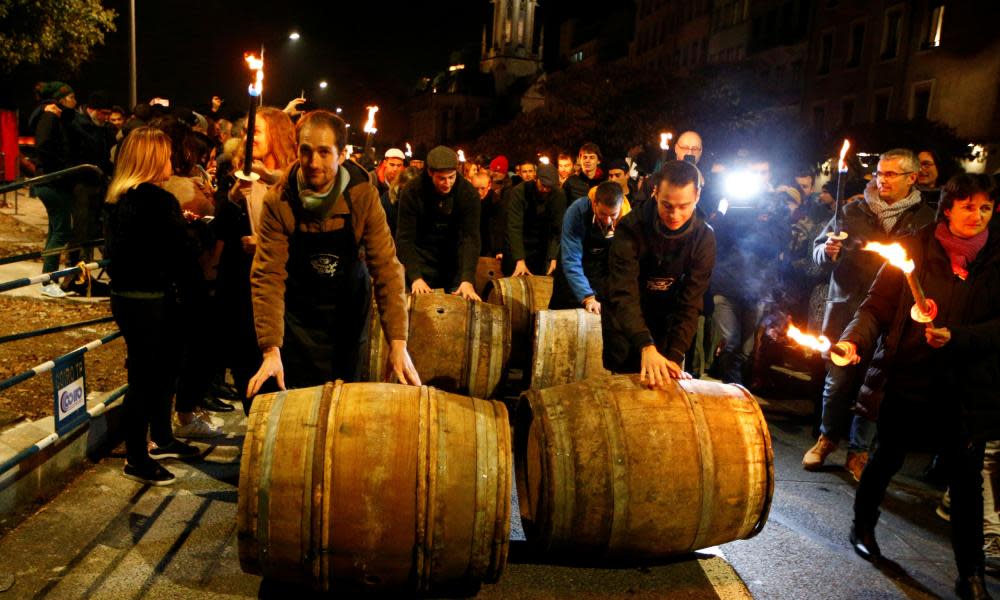The unloved wines I wish we drank more often

Beaujolais, riesling, muscadet … so many styles that fell off wine lists after the 1980s are well worth revisiting
What is it that makes some wines popular and others beyond the pale? For example, during the 2010s the southern French dry white picpoul de pinet became a must-have for every supermarket and wine bar. It was often sold as the Languedoc’s answer to muscadet. And yet, while picpoul can be perfectly nice in a clean, doesn’t touch the sides, refreshing with seafood sort of way, and reasonably priced, it’s never exactly thrilling.
Muscadet itself, meanwhile, can be awful: painfully tart, sour and mean, a fact that may account for its loss of popularity since it was a staple of wine lists in the 1970s and 80s. But the good bottles are so much more exciting than the rows of quite good picpoul; at their saline, yeasty, lemony best (Jean-François Baron Muscadet Sèvre et Maine Sur Lie 2020; £11.25, yapp.co.uk) they are an economical alternative to chablis. They’d be at the top of any list I might draw up of “neglected wines I wish people drank more of”.
The rest of the list is dominated by fallen European giants: once-popular styles nudged out of fashion by the boom in New World wine, or that remain tainted with memories of bad wines past. You might put German riesling in the latter category. The often-thrilling dry and off-dry wines of today, with their spine-tingling flash of silvery acidity, are nothing like the sweet sugar-water liebfraumilchs of yesteryear.
Next would be beaujolais: the complex and gluggable best of the region – including the new generation of beaujolais nouveau – is in a different league to the bubblegum and banana-scented stuff remembered from cross-Channel booze cruises. Although these wines might have lost their places in the mainstream they have a small but growing cult audience among wine geeks. The same is true for another once all-conquering bestseller, sherry, which has been unpopular enough for the past 40 years to be absurdly cheap and for which I’m a vociferous, bordering-on-tedious evangelist, much like every other wine professional I know.
Other styles that deserve a wider audience come from regions that have never really been popular with anyone apart from the locals. There is so much to enjoy in the indigenous varieties and distinctive flavours emerging from the modern scenes in Portugal, Greece, Slovenia and Croatia.
But if I were to pick out the single, currently neglected wine that I reckon would add the most pleasure to people’s lives if only they’d try it, it wouldn’t be a specific region or grape variety: it’s a whole genre, encompassing such glittering golden gems as sauternes, barsac, tokaji, monbazillac, coteaux du layon, icewine or eiswein and the German and Austrian rieslings known as trockenbeerenauslese. I wish more people gave themselves the chance to experience the heady, luxurious delights of the world’s great dessert wines.
Six wines that are due a comeback
Williams & Humbert Alegria Manzanilla Spain NV (£5.49, 37.5cl, Waitrose)
Perennially on the brink of a comeback, but never coming close to its 20th-century sales heyday, sherry is absurdly good value. This is an example of the lightest, raciest style from estuarine Sanlúcar, a crisp, fresh, nutty, yeasty and salty match for seafood.
M&S Classics Mineralstein Riesling Pfalz, Germany 2020 (£9.50, Marks & Spencer)
Riesling is a flexible grape variety, capable of making everything from austerely dry to full-on lusiciously sweet, but the best examples always have a spine of invigorating steely acidity, plus, as is the case here, some mouthwatering lime skin tanginess and tropical fruit fleshiness.
Domaines des Forges Côteaux du Layon Chaume Loire, France 2018 (£10.78, 37.5cl, justerinis.com; laywheeler.com)
An example of two things the world needs more of: the great white grape variety chenin blanc, and golden dessert wines that are luscious yet balanced with scintillating acidity, this is a simply gorgeous partner for strong hard or blue cheese.
Terra d’Alter ALF Alfrocheiro Alentejo, Portugal 2020 (from £10.95, leaandsandeman.co.uk; butlers-winecellar.co.uk; flagshipwines.co.uk)
Portugal is arguably still best known in the UK for its peerless fortified wines: port and madeira. The 21st century has seen a renaissance of the country’s table wines, with this juicy, brambly fruited, supple southern red from the native alfrocheiro variety just brilliant value.
Oenops Wines Apla White Drama, Greece 2020 (£12.88, laywheeler.com)
Greece is an absolutetrove of distinctive wine that has never quite made it over the line into mainstream acceptance in the UK. This typically lemon grove-fragrant, floral, zippy white blend of malagouzia, assyrtiko, roditis and muscat is the perfect introduction.
Francesco Rinaldi Dolcetto d’Alba Roussot Piedmont, Italy 2020 (from £15.95, thewhiskyexchange.com; handford.net; noblegreenwines.co.uk)
Italy’s answer to Beaujolais is the Piemontese red wine made from dolcetto. Like its French counterpart it used to be much more popular in the UK and the examples from top modern producers such as Rinaldi are a big improvement on the past: all vibrant vivid dark cherry, herbs and freshness.

 Yahoo News
Yahoo News 
